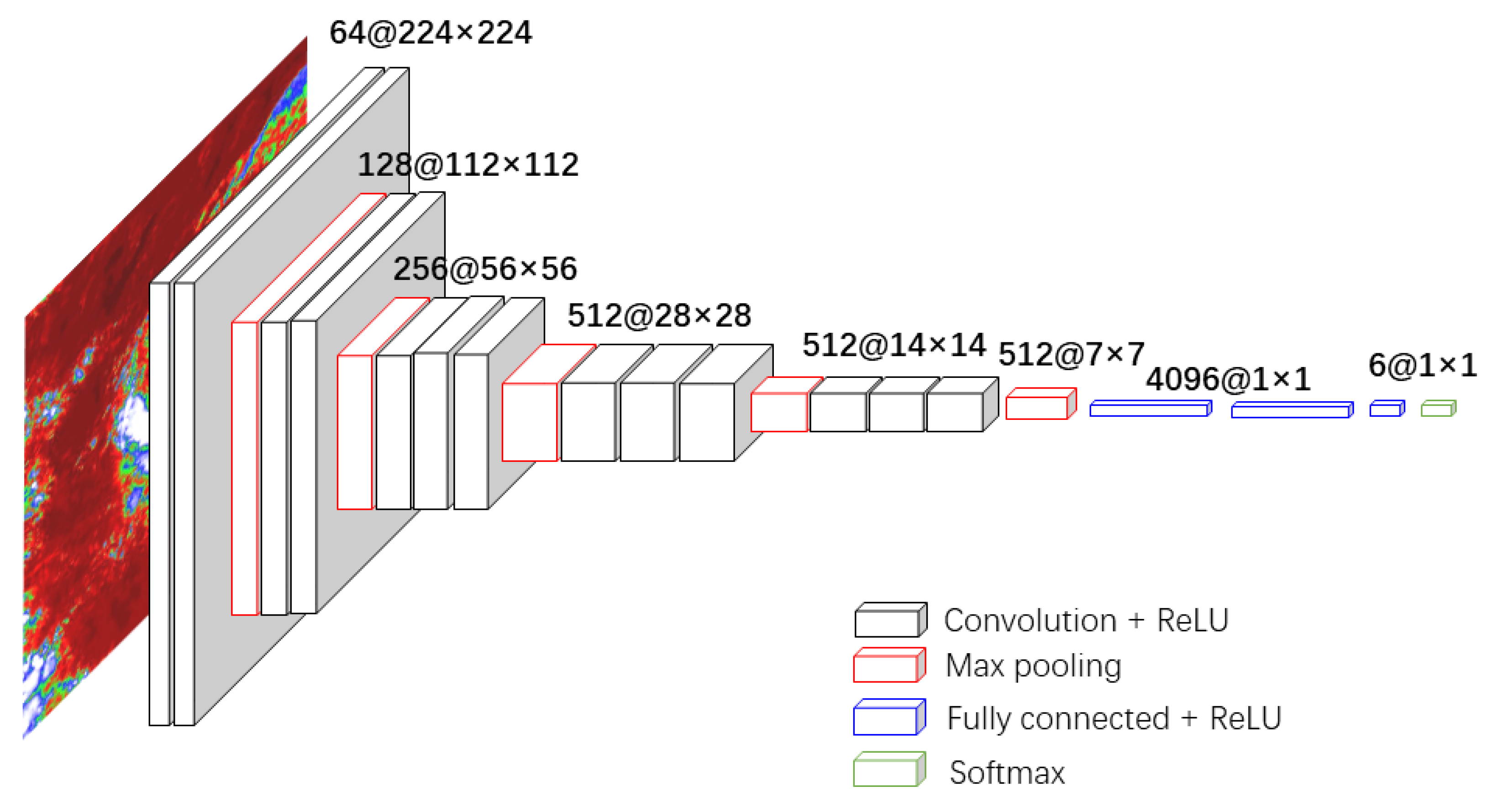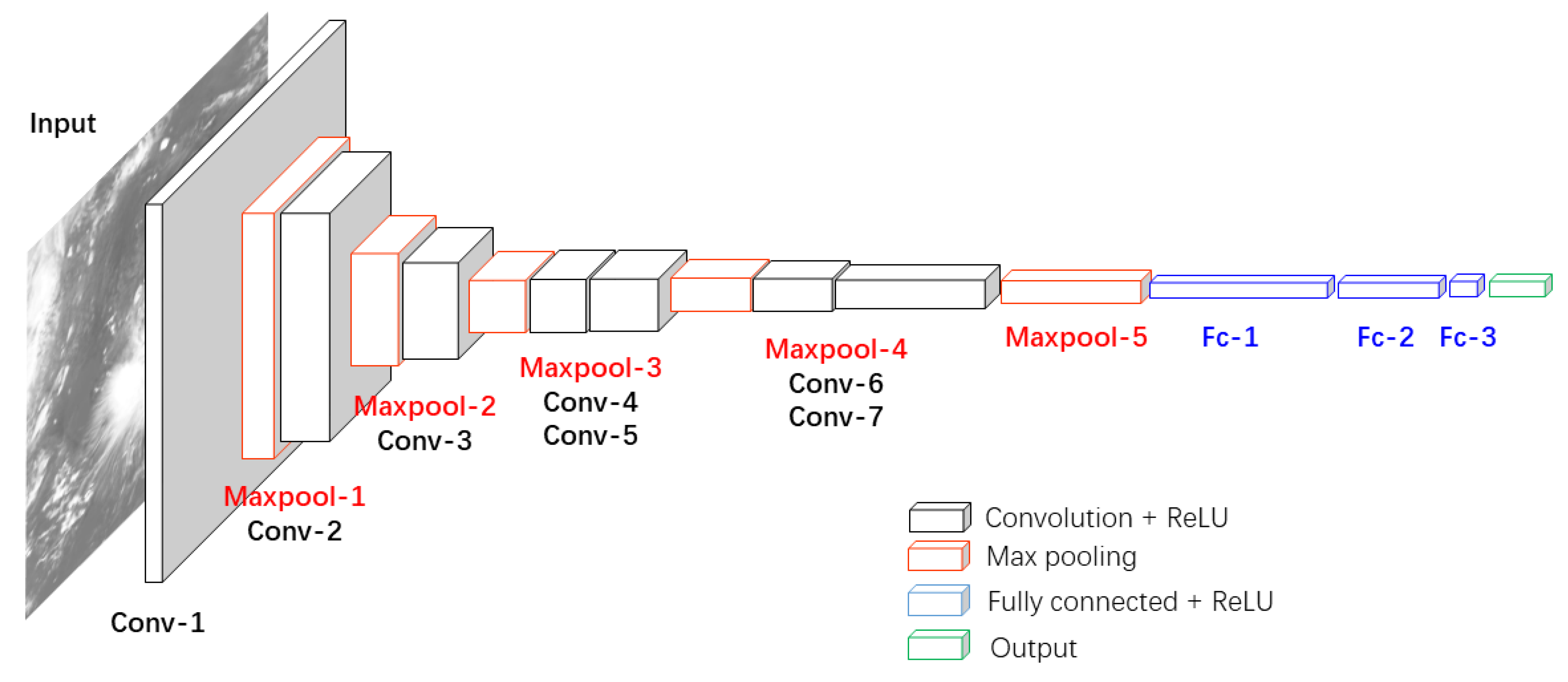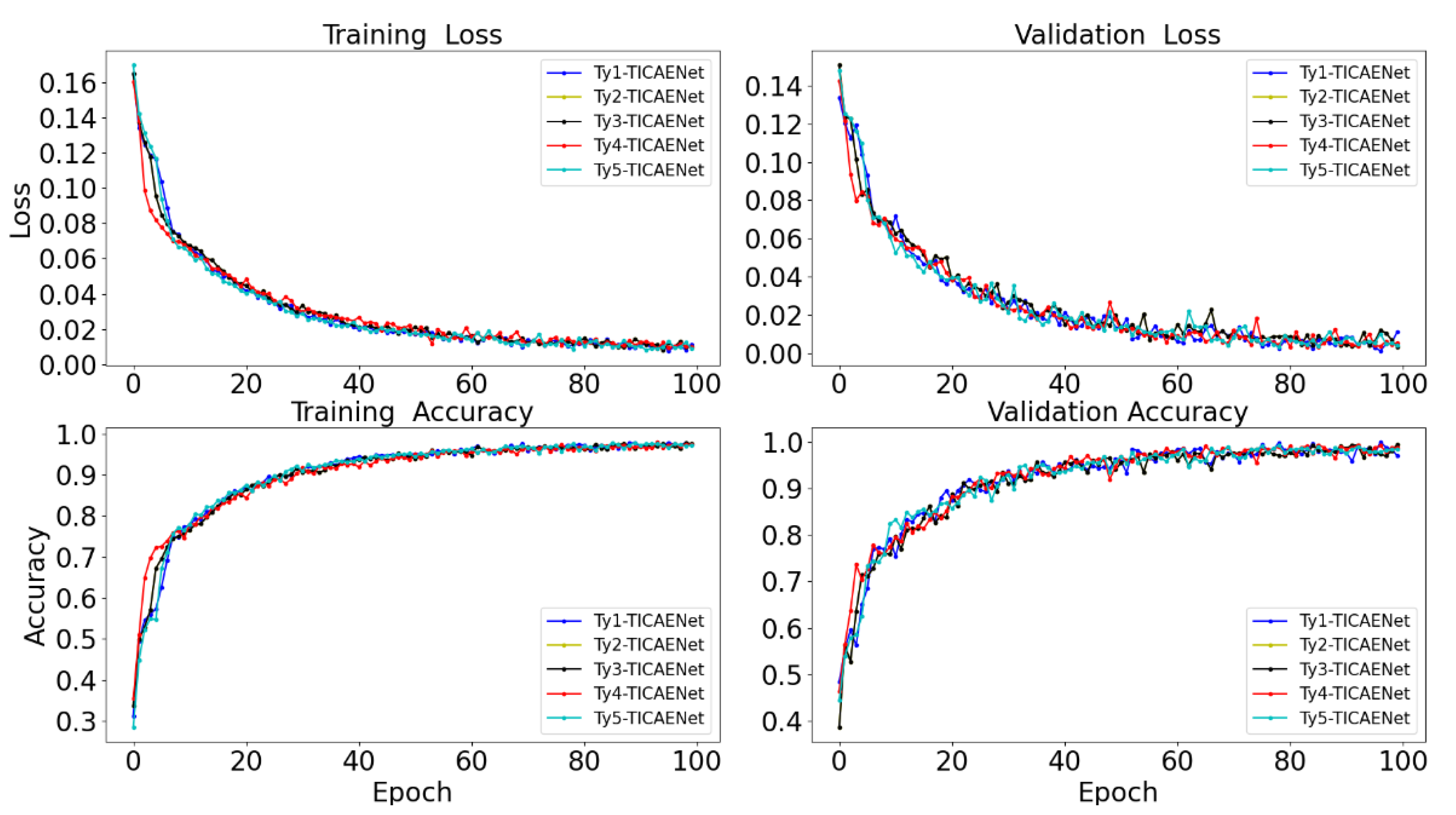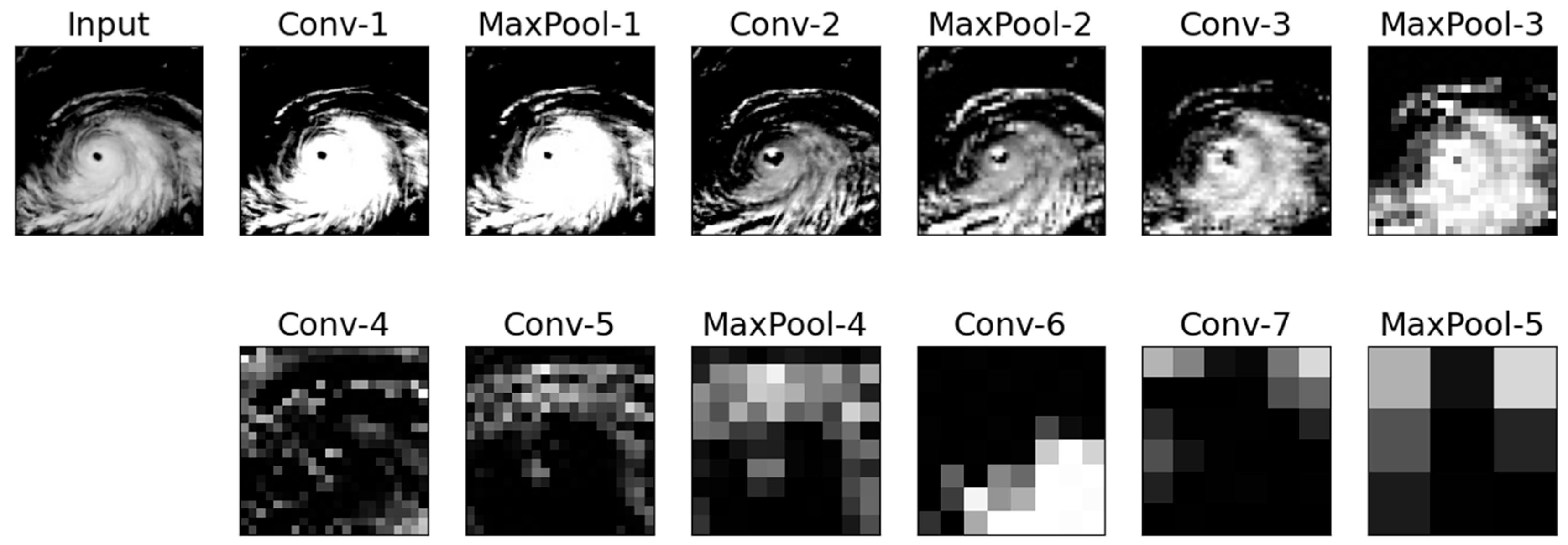1. Introduction
Typhoons are one of the most destructive natural disasters in coastal areas of China and have a great impact on economic development, navigation safety, infrastructure construction and people’s lives and properties in coastal areas. Tropical cyclones and the heavy rains that accompany them are among the deadliest and most destructive disasters on Earth, especially in coastal areas [
1,
2]. More than seven typhoons strike the southeast coast of China each year according to the China Meteorological Administration (CMA). Among them, typhoons Nina and LeKima caused extensive economic loss and affected millions of people [
3,
4,
5]. It is of great significance to classify and estimate typhoon intensity accurately to ensure the safety of both people and property. According to geostationary satellite imagery analysis, different typhoon levels have different cloud features, which can be used to help recognize typhoon intensity [
6]. For research on typhoon intensity recognition, there are subjective empirical methods and numerical simulation methods. Subjective experience methods are affected by the nature of the typhoon. Numerical models are more efficient and systematic than subjective empirical methods in terms of calculations, and numerical models account for the influence of typhoon parameters on identification. However, numerical models are limited in predicting some extreme events due to the data collection and processing times [
6,
7]. Therefore, there is a critical need to establish a high-precision typhoon intensity recognition model to study typhoons.
Recently, as a result of continuous breakthroughs in image processing and deep learning applications, many scholars have introduced recognition systems and deep learning models into different disciplines. For example, Duan et al. [
8] compared four ML methods, i.e., random forest (RF), support vector machine (SVM), convolutional neural network (CNN) and residual neural network (ResNN) in classifying the signals obtained from the recorded seismic dataset. Liu et al. [
9] developed a software system for big data management, which fulfills the tasks of collecting, transmitting, classifying, screening, managing and analyzing, based on more than 80,000 sets of standard geo-material physico -mechanical data. Some progress has also been made in identifying satellite cloud images using different cloud cluster features [
10,
11]. Zhou et al. [
12] accurately identified the eye and cloud wall of typhoons and used the GC-LSTM model to accurately recognize and predict typhoon intensity. Zhao et al. [
13] proposed a real-time typhoon eye detection method based on deep learning with satellite cloud images, which provided important data for detecting real typhoon information. Wang et al. [
14] designed several models with different inputs and parameters and found that their CNN models were robust when estimating the TC intensity from geostationary satellite images. Zhang et al. [
15] proposed a novel tropical cyclone intensity classification and estimation model using infrared geostationary satellite images from the Northwest Pacific Ocean basin and a cascading deep convolutional neural network. Rüttgers et al. [
16] used past satellite images to generate one-step images. Nevertheless, there are existing issues in terms of low feature extraction of tropical depressions, tropical storms or severe tropical storms and poor recognition accuracy that need to be addressed [
12,
15,
17].
In terms of visual computing, the core challenges include the acquisition, processing, analysis and rendering of visual information (mainly images and video) [
18]. Shallow neural networks have problems such as poor feature extraction and classification ability, while deep neural networks have problems such as difficult development and long training times [
19,
20]. Shallow neural network can meet some current requirements, but it may not be effective in identifying satellite cloud images. Given enough time, deep neural networks may have better results, but waste computational resources. The most straightforward way to improve network performance is to increase the network depth, which increases the number of parameters and the difficulty in developing the network. In addition, the network becomes more prone to overfitting, and the demand for computing resources increases significantly. Recently, much research has been carried out to improve algorithms. Simonyan et al. [
21] found that by using a 3 × 3 convolution kernel and increasing the network depth to 16–19 weight layers, they could achieve a significant improvement over existing network framework. He et al. [
22] proposed a simpler and more accurate residual learning framework to address the problem of gradient disappearance caused by deep networks. Tan et al. [
23] proposed a new mixed depthwise convolution (MixConv) model that naturally combines multiple kernel sizes into a single convolution and improves the accuracy and efficiency of existing Mobile Nets for both ImageNet classification and COCO object detection. Szegedy et al. [
24] found that by using smaller filters to extract local features, such as replacing a 5 × 5 convolution kernel with the superposition of two 3 × 3 convolution kernels, the computational efficiency could be improved. However, few studies have determined how many small convolution kernels are necessary to replace large kernels to improve the computational efficiency and recognition accuracy.
Here, we focus on solving two problems, the poor feature extraction of satellite cloud images and the elaboration of a novel model to improve algorithms. The model was trained and validated using 25 years of typhoon sample images. The results indicated that the model can be used to extract relatively complex information from satellite cloud images and accurately identify and estimate typhoon intensity, especially for tropical depressions, tropical storms and severe tropical storms.
The remainder of this paper is organized as follows. In
Section 2, we briefly describe the data sources and preprocessing, and introduce the method. In
Section 3, first, we choose the optimal convolutional kernel by comparing various convolutional kernel performances according to LeNet-5 model characteristics. Next, we build a new framework based on the advantages of the VGG16 model and elaborate a series of models based on the new framework. Then, we compare various model performances and present typhoon intensity classification and estimation effects. Finally, the conclusions are presented in
Section 4.
4. Discussion and Conclusions
With the development of deep learning, many scholars use it as a tool in the field of marine meteorology to realize the classification and recognition of satellite cloud images. The core challenge of visual computing is the acquisition, processing, analysis and presentation of visual information, primarily images and video. At present, deep learning has low accuracy in the identification of typhoon intensity and tropical depression, and it is difficult to extract cloud image features. Studies have shown that feature information can be better extracted by using smaller convolution kernels instead of a larger convolution kernel. However, few studies have determined how many small convolution kernels are needed to replace large ones to improve computational efficiency and recognition accuracy. Therefore, it is critical to develop an accurate model for identifying and evaluating typhoon intensity.
In this paper, we first used the framework of five convolution layers with the network topology architecture of the LeNet-5 model to elaborate a series of models by using various convolution kernel sizes. The 5 × 5 convolution kernel extracted satellite cloud image information more effectively than the other kernels. Then, based on the characteristics of the VGG16 model and replacing a 5 × 5 convolution kernel with two 3 × 3 convolution kernels, we built a new framework combining two-layer convolution and one-layer pooling with one-layer convolution and one-layer pooling. A series of hybrid convolution models were successively adopted to determine the best combination and achieve better recognition performance by combining the advantages of the LeNet-5 model with the VGG16 model. These models had an appropriate network depth and efficiently processed these problems based on satellite images of the Northwest Pacific Ocean and the South China Sea. The experimental results showed that the TICAENet model had better recognition performance, and it can efficiently extract sensitive features such as typhoon eyes, cloud belts and dense cloud areas. The model indicators showed that the accuracy, precision, sensitivity and F1 score of the TICAENet model were 97.12%, 97.13%, 97.12% and 97.12%, respectively, which are higher than those of the other models. Compared with the LeNet-5 model, the accuracy and sensitivity of the model were improved by 10.57%. On the basis of the TICAENet model, the maximum probability linear estimation method was used to achieve a quantitative estimation of the typhoon wind speed, with an MAE of 4.78 m/s and RMSE of 6.11 m/s. The estimation accuracy is 18.98% and 20.65% higher than that of the statistical method respectively. Compared with DAVT, K-nearest-neighbors algorithm and linear regression of IR features, TICAENet is more useful for estimating intensity, and its estimation accuracy is 8.26%, 6.43% and 10.01% higher respectively. The model takes less memory and runs faster. It indicates that the TICAENet model has high research value and application prospects for typhoon intensity estimation. Therefore, it is suggested from this study that the TICAENet model is better for identifying typhoon intensity using satellite images, providing a solid basis for relevant organizations to make decisions and laying the foundation for subsequent typhoon intensity classification, identification and prediction.
Although we performed many experiments with various models, there were some deficiencies due to the limitations of objective factors: (1) the experiment lacked an analysis of actual typhoon detection cases; (2) actual application analysis with a large amount of data is not involved. In the future, we will continue in-depth research in these two areas. Additionally, to further improve the model performance, we will focus on combining an RNN (recurrent neural network) with the model and adjust the network model.















